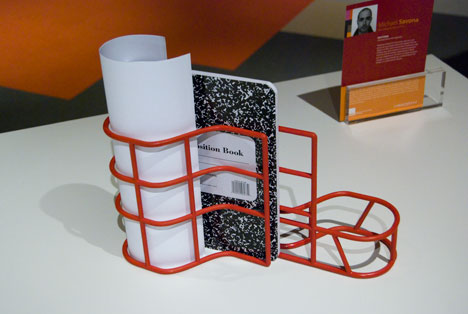NeoCon 2010: New ways to organize paper at Haworth

In the sea of contract furniture and endlessly customizable systems, it was refreshing to run across these small student projects sprinkled throughout Haworth's showroom from the School of the Art Institute of Chicago. Strangely (or maybe not surprisingly), the sales staff didn't know much about them (even how many there were), but, from what we could tell, they all proposed new ways to organize desktop paper. Upon closer inspection, many of these systems stayed open to the inherent organizational systems of individuals, providing a means to represent them physically instead of circumventing them.
For example, Sprout, by Xin Wang, is a disembodied file organization system that use color coded tabs as paper stands/clamps. They are magnetized and can hold paper upright on a desk, hanging from an overhead storage system, or outwards on vertical panels. A combination of increased visual contact, color coding, and free placement is meant to encourage memory and the locating of paperwork. Similarly, Wedge, by EunJung Grace, is a magnetic set of stacking in/out trays that can be stacked in different orientations depending on use.

Michael Savona uses ambiguity as a means of organization. One's filing system may seem arbitrary to others, but could actually be a powerful, intuitive memory tool. In response his desktop "fence," Daytona, can take on multiple forms: a sculptural paper storage tray, a bookend, a desktop tool holder, a safe home for liquids, or all of the above, depending on the individual.
More projects after the jump.
Softprint by David M. Krell Your softprint shelf provides a defined place for your personal items in the work place. The weight of these items leads to the reveal of their given home. This creates a habitual and memorable routine. Larger items such as books, journals or lunch boxes are stored on the left. Keys are held in the home imprint, and hones or cameras can be charged and placed on the far right.

Leaffle Wobbleby SungUn Chang People rely on memos to help them remember important information. Unfortunately, we often forget to actually check these memos and end up missing appointments or falling behind on our schedules. Leaffle Wobble actively sends visual signals and makes memos stand out in a crowded desk space b utilizing the technique of a weeble wobble toy. It will jiggle from contact force created by small movements of the dsdek or objects around it, and catch the user's attention.

Co-Tray by QingChang Wang The interaction between top divider and bottom "stair tray" creates a hierarchy of files/folders, and the color gradient helps to differentiate them for easy recall. The front panel on the top divider allows users to mark each category.
-
oFavorite This
-
Q3Comment
K
{Welcome
Create a Core77 Account
Already have an account? Sign In
By creating a Core77 account you confirm that you accept the Terms of Use
K
Reset Password
Please enter your email and we will send an email to reset your password.


Comments